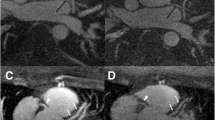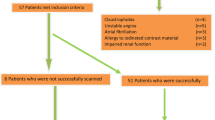Abstract
Gadolinium enhanced coronary magnetic resonance angiography (MRA) at 3 T appears to be superior to non-contrast methods. Gadofosveset is an intravascular contrast agent that may be well suited to this application. The purpose of this study was to perform an intra-individual comparison of gadofosveset and gadobenate for coronary MRA at 3 T. In this prospective randomized study, 22 study subjects [8 (36 %) male; 27.9 ± 6 years; BMI = 22.8 ± 2 kg/m2] underwent two studies using a contrast-enhanced inversion recovery three-dimensional fast low angle shot MRA at 3 T. The order of contrast agent administration was varied randomly, separated by an average of 30 ± 5 days, using either gadobenate dimeglumine (Gd-BOPTA; Bracco, 0.1 mmol/Kg) or gadofosveset trisodium (MS-325; Lantheus Med, 0.03 mmol/Kg). Acquisition time, signal-to-noise ratio (SNR) of coronary vessels and contrast-to-noise ratio (CNR) were evaluated. Of 308 coronary arteries and veins segment analyzed, overall SNR of coronary arteries and veins segments were not different for the two contrast agents (132 ± 79 for gadofosveset vs. 135 ± 78 for gadobenate, p = 0.69). Coronary artery CNR was greater for gadofosveset in comparison to gadobenate (73.5 ± 46.9 vs. 59.3 ± 75.7 respectively, p = 0.03). Gadofosveset-enhanced MRA images displayed better image quality than gadobenate-enhanced MRA images (2.77 ± 0.61 for gadofosveset vs. 2.11 ± 0.51, p < .001). Inter- and intra-reader variability was excellent (ICC > 0.90) for both contrast agents. Gadofosveset trisodium appears to show slightly better performance for coronary MRA at 3 T compared to gadobenate.



Similar content being viewed by others
References
Banerjee A, Newman DR, Van den Bruel A, Heneghan C (2012) Diagnostic accuracy of exercise stress testing for coronary artery disease: a systematic review and meta-analysis of prospective studies. Int J Clin Pract 66:477–492
Shah DJ, Kim HW, Kim RJ (2009) Evaluation of ischemic heart disease. Heart Fail Clin 5:315–332, v
Lemmert ME, de Vreede-Swagemakers JJ, Eurlings LW et al (2012) Electrocardiographic predictors of out-of-hospital sudden cardiac arrest in patients with coronary artery disease. Am J Cardiol 109:1278–1282
Rhee CM, Bhan I, Alexander EK, Brunelli SM (2012) Association between iodinated contrast media exposure and incident hyperthyroidism and hypothyroidism. Arch Intern Med 172:153–159
Mc Laughlin PD, O’Connor OJ, O’Neill SB, Shanahan F, Maher MM (2012) Minimization of radiation exposure due to computed tomography in inflammatory bowel disease. ISRN Gastroenterol 2012:790279
Craig O, O’Neill S, O’Neill F et al (2012) Diagnostic accuracy of computed tomography using lower doses of radiation for patients with Crohn’s disease. Clin Gastroenterol Hepatol 10(8):886–892
Prompona M, Cyran C, Nikolaou K, Bauner K, Reiser M, Huber A (2009) Contrast-enhanced whole-heart MR coronary angiography at 3.0T using the intravascular contrast agent gadofosveset. Invest Radiol 44:369–374
Gweon HM, Kim SJ, Lee SM, Hong YJ, Kim TH (2011) 3D whole-heart coronary MR angiography at 1.5T in healthy volunteers: comparison between unenhanced SSFP and Gd-enhanced FLASH sequences. Korean J Radiol 12:679–685
Liu X, Bi X, Huang J, Jerecic R, Carr J, Li D (2008) Contrast-enhanced whole-heart coronary magnetic resonance angiography at 3.0 T: comparison with steady-state free precession technique at 1.5 T. Invest Radiol 43:663–668
Bi X, Deshpande V, Simonetti O, Laub G, Li D (2005) Three-dimensional breathhold SSFP coronary MRA: a comparison between 1.5T and 3.0T. J Magn Reson Imaging 22:206–212
Bi X, Carr JC, Li D (2007) Whole-heart coronary magnetic resonance angiography at 3 Tesla in 5 minutes with slow infusion of Gd-BOPTA, a high-relaxivity clinical contrast agent. Magn Reson Med 58:1–7
Kotys MS, Herzka DA, Vonken EJ et al (2009) Profile order and time-dependent artifacts in contrast-enhanced coronary MR angiography at 3T: origin and prevention. Magn Reson Med 62:292–299
Gharib AM, Herzka DA, Ustun AO et al (2007) Coronary MR angiography at 3T during diastole and systole. J Magn Reson Imaging 26:921–926
Gharib AM, Abd-Elmoniem KZ, Ho VB et al (2012) The Feasibility of 350 mum Spatial Resolution Coronary Magnetic Resonance Angiography at 3 T in Humans. Invest Radiol 47:339–345
Rohrer M, Bauer H, Mintorovitch J, Requardt M, Weinmann HJ (2005) Comparison of magnetic properties of MRI contrast media solutions at different magnetic field strengths. Invest Radiol 40:715–724
Bock M, Schulz J, Ueltzhoeffer S, Giesel F, Voth M, Essig M (2008) Intravascular contrast agent T1 shortening: fast T1 relaxometry in a carotid volunteer study. Magma 21:363–368
Lauffer RB, Parmelee DJ, Dunham SU et al (1998) MS-325: albumin-targeted contrast agent for MR angiography. Radiology 207:529–538
Scanlon PJ, Faxon DP, Audet AM et al (1999) ACC/AHA guidelines for coronary angiography: executive summary and recommendations. A report of the American College of Cardiology/American Heart Association Task Force on Practice Guidelines (Committee on Coronary Angiography) developed in collaboration with the Society for Cardiac Angiography and Interventions. Circulation 99:2345–2357
Prompona M, Cyran C, Nikolaou K, Bauner K, Reiser M, Huber A (2010) Contrast-enhanced whole-heart coronary MRA using Gadofosveset 3.0 T versus 1.5 T. Acad Radiol 17:862–870
Frydrychowicz A, Russe MF, Bock J et al (2010) Comparison of gadofosveset trisodium and gadobenate dimeglumine during time-resolved thoracic MR angiography at 3T. Acad Radiol 17:1394–1400
Wagner M, Rief M, Asbach P et al (2010) Gadofosveset trisodium-enhanced magnetic resonance angiography of the left atrium–a feasibility study. Eur J Radiol 75:166–172
Aime S, Caravan P (2009) Biodistribution of gadolinium-based contrast agents, including gadolinium deposition. J Magn Reson Imaging 30:1259–1267
Caravan P (2009) Protein-targeted gadolinium-based magnetic resonance imaging (MRI) contrast agents: design and mechanism of action. Acc Chem Res 42:851–862
Nassenstein K, Waltering KU, Kelle S et al (2008) Magnetic resonance coronary angiography with vasovist: in vivo T1 estimation to improve image quality of navigator and breath-hold techniques. Eur Radiol 18:103–109
Kelle S, Thouet T, Tangcharoen T et al (2007) Whole-heart coronary magnetic resonance angiography with MS-325 (Gadofosveset). Med Sci Monit 13:CR469–CR474
Knopp MV, Giesel FL, von Tengg-Kobligk H et al (2003) Contrast-enhanced MR angiography of the run-off vasculature: intraindividual comparison of gadobenate dimeglumine with gadopentetate dimeglumine. J Magn Reson Imaging 17:694–702
Schneider G, Maas R, Schultze Kool L et al (2003) Low-dose gadobenate dimeglumine versus standard dose gadopentetate dimeglumine for contrast-enhanced magnetic resonance imaging of the liver: an intra-individual crossover comparison. Invest Radiol 38:85–94
Kuwatsuru R, Kadoya M, Ohtomo K et al (2001) Comparison of gadobenate dimeglumine with gadopentetate dimeglumine for magnetic resonance imaging of liver tumors. Invest Radiol 36:632–641
Balci NC, Inan N, Anik Y, Erturk MS, Ural D, Demirci A (2006) Low-dose gadobenate dimeglumine versus standard-dose gadopentate dimeglumine for delayed contrast-enhanced cardiac magnetic resonance imaging. Acad Radiol 13:833–839
Grobner T (2005) Gadolinium—a specific trigger for the development of nephrogenic fibrosing dermopathy and nephrogenic systemic fibrosis? Nephrol Dial Transplant 21:1104–1108
Grobner T (2006) Gadolinium–a specific trigger for the development of nephrogenic fibrosing dermopathy and nephrogenic systemic fibrosis? Nephrol Dial Transpl 21:1104–1108
Perazella MA, Reilly RF (2011) Imaging patients with kidney disease: how do we approach contrast-related toxicity? Am J Med Sci 341:215–221
Niendorf T, Sodickson DK (2006) Parallel imaging in cardiovascular MRI: methods and applications. NMR Biomed 19:325–341
Acknowledgments
This research was supported by the NIH intramural research program. Clinical trial registration information—URL: http://www.clinicaltrials.gov. Unique identifier: NCT01130545 (10-CC-0115). Funded by the National Institutes of Health (NIH) Intramural program.
Conflict of interest
The authors declare they have no competing interests.
Author information
Authors and Affiliations
Corresponding author
Additional information
Fabio S. Raman and Marcelo S. Nacif contributed equally to this work.
Rights and permissions
About this article
Cite this article
Raman, F.S., Nacif, M.S., Cater, G. et al. 3.0-T whole-heart coronary magnetic resonance angiography: comparison of gadobenate dimeglumine and gadofosveset trisodium. Int J Cardiovasc Imaging 29, 1085–1094 (2013). https://doi.org/10.1007/s10554-013-0192-z
Received:
Accepted:
Published:
Issue Date:
DOI: https://doi.org/10.1007/s10554-013-0192-z




